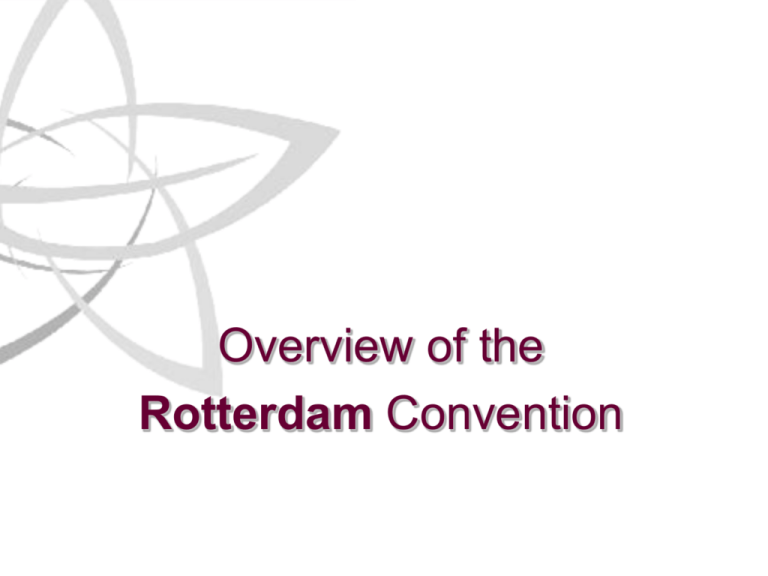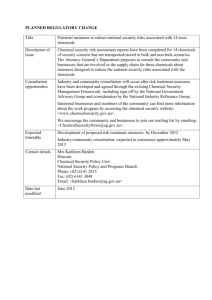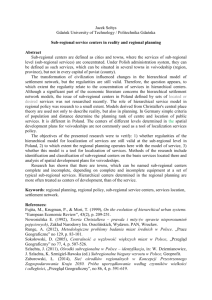Part 1 Introduction to the Rotterdam Convention
advertisement

Overview of the Rotterdam Convention Overview of the Rotterdam Convention Structure of the presentation Part 1 - Introduction to the Rotterdam Convention Part 2 - Operation of the Rotterdam Convention Part 3 - Benefits to its Parties 2 Sub-regional Consultation for DNAs Part 1 Introduction to the Rotterdam Convention • Objectives/scope/key provisions • Articles and Annexes of the Convention 3 Sub-regional Consultation for DNAs Objectives • To promote shared responsibility and cooperative efforts among Parties in the international trade of certain hazardous chemicals in order to protect human health and the environment from potential harm and to contribute to their environmentally sound use 4 Sub-regional Consultation for DNAs Meeting the Objectives How • Provides an early warning of potentially hazardous chemicals • Provides the basis for decisions regarding of future imports of chemicals (PIC procedure) • Helps to enforce those import decisions 5 Sub-regional Consultation for DNAs Scope of the Convention Applies to: • Chemicals banned or severely restricted to protect human health or the environment • Severely hazardous pesticide formulations (SHPF) - causing problems under conditions of use in developing countries or countries with economies in transition 6 Sub-regional Consultation for DNAs Key Provisions • PIC procedure - Provides for a national decision making process on import of hazardous chemicals in Annex III and attempts to ensure compliance with these decisions by exporting Parties • Information exchange - the exchange of information on a broad range of potentially hazardous chemicals 7 Sub-regional Consultation for DNAs Overview of Articles Article 1- 4: Objective, definitions, scope and DNAs role Article 5-14: Procedures for inclusion and removing of chemicals and for export and import of chemicals Article 15-30: General obligations and common clauses 8 Sub-regional Consultation for DNAs Overview of Annexes Annex I Information requirements for notifications made pursuant to Article 5 Annex II Criteria for listing banned or severely restricted chemicals in Annex III Annex III Chemicals subject to the PIC procedure Annex IV Information and criteria for listing severely hazardous pesticide formulations in Annex III Annex V Information requirements for export notification Annex VI Settlement of Disputes 9 Sub-regional Consultation for DNAs Overview of the Rotterdam Convention Structure of the presentation Part 1 - Introduction to the Rotterdam Convention Part 2 - Operation of the Rotterdam Convention Part 3 - Benefits to its Parties 10 Sub-regional Consultation for DNAs Part 2 Operation of the Rotterdam Convention Key Players • Who they are and what they do Key Provisions • What they are and how they operate 11 Sub-regional Consultation for DNAs Key Players 1. Designated National Authorities (DNAs) 2. Conference of the Parties (COP) 3. Chemical Review Committee (CRC) 4. Secretariat 12 Sub-regional Consultation for DNAs 1. Designated National Authorities Generally government departments responsible for policy decisions and regulation of pesticides or industrial chemicals Key contact point for the secretariat regarding the implementation of the convention Responsible for coordinating actions at the national level to ensure compliance with the Convention e.g. government ministries, exporters, importers, customs authorities 13 Sub-regional Consultation for DNAs 1. Designated National Authorities DNA Guidance document detailed technical guidance on the implementation of all aspects of the Convention • • • • • non legal explanation of the key obligations text of the Convention forms and instructions frequently asked questions available in English, French and Spanish sent to all DNAs available from the Secretariat and on Convention website 14 Sub-regional Consultation for DNAs 2. Conference of the Parties (COP) Highest authority of the Convention Oversees the implementation of the Convention – including policy issues, programme of work and budget, inclusion of chemicals in Annex III, establishes subsidiary bodies Meets every two years – next session October 2008 15 Sub-regional Consultation for DNAs 3.Chemical Review Committee (CRC) Composed of government designated experts in chemicals management Reviews notifications of final regulatory actions and proposals from Parties Makes recommendations to COP on the addition of chemicals to Annex III 16 Sub-regional Consultation for DNAs CHEMICAL REVIEW COMMITTEE 31 members distributed as follows: •8 •8 •3 •5 African States Asian and Pacific States Central and Eastern European States Latin American and Caribbean States • 7 Western European and other States 17 Sub-regional Consultation for DNAs 4. Secretariat Provided jointly by UNEP and FAO – Convenes meetings of the COP and CRC – Facilitates assistance to Parties in implementation of the Convention – Coordinates with regional and international partners Unique example of cooperation between UN organizations 18 Sub-regional Consultation for DNAs Key Provisions PIC procedure - Provide for a national decision making process on import of hazardous chemicals in Annex III and to ensure compliance with these decisions by exporting Parties Information exchange - the exchange of information on a broad range of potentially hazardous chemicals 19 Sub-regional Consultation for DNAs Key provision: PIC Procedure Key elements Decision Guidance Documents (DGD) Import response PIC Circular Responsibilities of importing and exporting Parties 20 Sub-regional Consultation for DNAs Key provision: PIC Procedure Decision Guidance Documents (DGD) describes the reasons for national actions to ban or severely restrict the chemical that were the basis for the chemical being listed in Annex III lists what uses have been prohibited and what if any uses remain in the notifying Parties as well as information on alternatives contains basic information about the chemical including a summary of the principal toxicological and eco-toxicolgical properties further sources of information including evaluations from internationally recognized sources e.g. WHO/IPCS 21 Sub-regional Consultation for DNAs Key provision: PIC Procedure Import response (Article 10) shall consist of either: Final decision • to consent to import • not to consent to import • to consent subject to specified conditions Interim response, including • • • • an interim decision to import or not to import a statement that a final decision is under consideration a request for further information a request for assistance in evaluating the chemical 22 Sub-regional Consultation for DNAs Key provision: PIC Procedure PIC CIRCULAR (Articles 10 and 11) Issued every six months, December and June, sent to all DNAs and posted on website Provides Parties with listing of all import decisions Updated list of Designated National Authorities Key document - basis for compliance with the import decisions 23 Sub-regional Consultation for DNAs Key provision: PIC Procedure Article 10 Importing Party Responsibilities ensure that importers, relevant authorities and where possible users are informed of import responses received ensure that import decisions apply uniformly to imports from all exporting countries and to any domestic manufacturing of the chemical for domestic use 24 Sub-regional Consultation for DNAs Key provision: PIC Procedure Exporting Party Responsibilities Articles 11 & 13 implement legislative and administrative measures to communicate import decisions within its jurisdiction take appropriate measures to ensure that exporters comply with import decisions ensure appropriate labeling and information accompanies exports 25 Sub-regional Consultation for DNAs Key provision: PIC Procedure Exporting Party Responsibilities Advise and assist importing Parties to obtain further information to help them make import decisions to strengthen their capacities and capabilities to manage chemicals safely 26 Sub-regional Consultation for DNAs Key provision: PIC Procedure SUMMARY 1. COP decides to make a chemical subject to the PIC Procedure 2. Secretariat circulates a DGD to all Parties 3. Parties submit import response for each chemical 4. Secretariat circulates all import responses to all Parties through the PIC Circular 5. Parties follow up on import / export responsibilities 27 Sub-regional Consultation for DNAs Key provision: Information Exchange Mechanism for the exchange of information on a broad range of potentially hazardous chemicals any chemical that is banned or severely restricted to protect human health or the environment severely hazardous pesticide formulations causing problems under the conditions of use 28 Sub-regional Consultation for DNAs Key provision: Information Exchange Key Elements PIC Circular Export notifications Information to accompany export 29 Sub-regional Consultation for DNAs Key provision: Information Exchange PIC Circular (Articles10 & 11) issued every six months, December and June, sent to all DNAs and posted on website summaries of notifications of regulatory actions to ban or severely restrict a chemical – reasons for the ban or severe restriction summaries of proposals for severely hazardous pesticide formulations – description of the conditions of use 30 Sub-regional Consultation for DNAs Key provision: Information Exchange Export notification (Article 12) Notify importing Party when exporting a chemical that is banned or severely restricted in its territory first shipment annually notification includes information in Annex V Importing DNA can request any information from Annex I which will have been summarized in PIC Circular 31 Sub-regional Consultation for DNAs Key provision: Information Exchange Information to accompany export (Article 13) ensure adequate labeling with regard to human health or environmental risks taking into account international standards accompanied by a safety data sheet chemicals in annex III are assigned Harmonized System codes 32 Sub-regional Consultation for DNAs Key provision: Information Exchange SUMMARY PIC Circular – summaries of notifications of national regulatory actions, import responses, contact details DNAs Export notification – an indication of the hazardous chemicals that are entering the country Information to accompany export – improved labeling and accompanying information in line with GHS, while HS Codes linked to work of the WCO will facilitate tracking of PIC chemicals 33 Sub-regional Consultation for DNAs Overview of the Rotterdam Convention Structure of the presentation Part 1 - Introduction to the Rotterdam Convention Part 2 - Operation of the Rotterdam Convention Part 3 - Benefits to Parties 34 Sub-regional Consultation for DNAs Part 3 Benefits to its Parties 1. 2. 3. 4. 5. 6. 7. Prevents unwanted trade Early warning system Informed decision-making Export notification Information accompanying export Network of DNAs Technical Assistance 35 Sub-regional Consultation for DNAs Benefits 1. Prevents unwanted trade SHARED RESPONSIBILITY PIC procedure is legally binding on Parties Importing Parties have a responsibility to make informed decisions regarding future import of chemicals listed in Annex III Exporting Parties have a responsibility to ensure that exports do not occur contrary to the import decisions of importing Parties 36 Sub-regional Consultation for DNAs Benefits 2. Early warning system PIC Circular provides information on notifications of regulatory actions to ban or severely restrict chemicals incidents (human poisoning and environmental damage ) associated with the use of severely hazardous pesticide formulations 37 Sub-regional Consultation for DNAs Benefits 3. Informed decision-making PIC Procedure Decision Guidance Documents provide the basis for a decision making process on future imports of chemicals listed in Annex III Information exchange information available through the PIC Circular as well as directly from other Parties can be used to inform/strengthen national decisions on hazardous chemicals 38 Sub-regional Consultation for DNAs Benefits 4. Export notification reminds importing Parties of a national regulatory actions in the exporting Party informs importing Parties that the chemical may be in use in their country Provides an opportunity to seek further information from the exporting Party 39 Sub-regional Consultation for DNAs Benefits 5. Information accompanying export Improved labeling and provision of safety data sheets assist importing countries to understand and manage potential risks – consistent with obligations under GHS HS Codes facilitate tracking PIC chemicals 40 Sub-regional Consultation for DNAs Benefits 6. Network of DNAs Access to DNAs in other countries with similar conditions Opportunities to exchange experience and information in the implementation of the Rotterdam Convention 41 Sub-regional Consultation for DNAs Benefits 7. Technical Assistance Parties cooperate in promoting technical assistance to develop the infrastructure and capacity required to implement the Convention Parties with more advanced systems to regulate chemicals provide technical assistance to other Parties 42 Sub-regional Consultation for DNAs





